I write this article to tell you about the identity of the Penang Chinese people. I feel this is an important message, because many people particularly the young, do not understand where they come from. In this article, I want to describe to you the meaning of being a Straits Chinese and a Sin Kheh, so that you would understand which group you belong to. You may say, "Baba Nyonya or Sin Kheh, what does it matter?" It matters if you are interested in your own roots. If you aren't, then leave it be.
In the past few years, particularly after the inner city of George Town was inscribed as a World Heritage Site, there was a surge of interest in local heritage. However, on the whole, the knowledge of most people about local heritage is still not indepth. It is lamentable that we care so much for our tangible heritage - the buildings - while at the same time our intangible heritage is neglected.
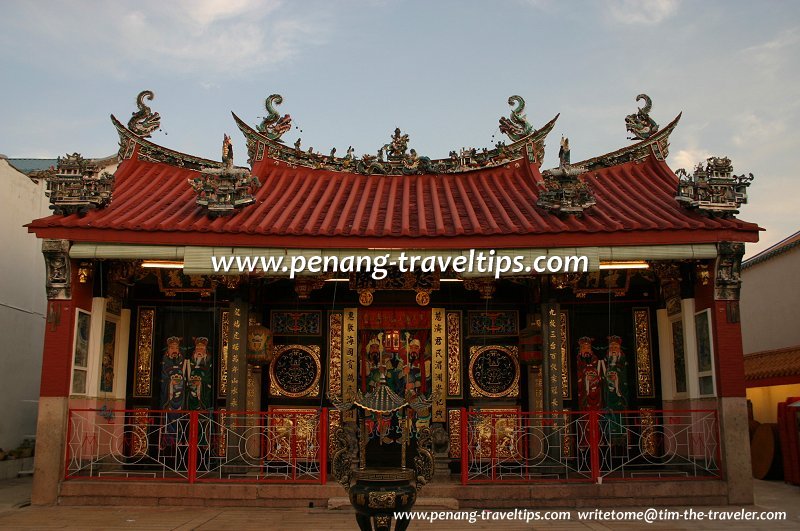 Lim Kongsi Ancestral Temple, one of the heritage sites of George Town (13 February 2005)
Lim Kongsi Ancestral Temple, one of the heritage sites of George Town (13 February 2005)
One area which I want to address through this article is the identity and history of the Penang Chinese people. Growing up in Penang, I have heard terms like Baba Nyonya and Sin Kheh, and I don't really pay much attention to what they mean. And when I started becoming interested in history and heritage, I began my quest for answers. Yet I was surprised that many people could not explain these terms to my satisfaction.
What makes a person Baba Nyonya, or in English, Straits-born. The term Baba Nyonya is more closely associated with the Straits Chinese of northern Malaya, while Peranakan is for those from Malacca down to Singapore. Are they the same group of people? Linguistic differences suggest that they aren't. But to understand their difference required me to dig deeper in my search for the Penang Chinese identity.
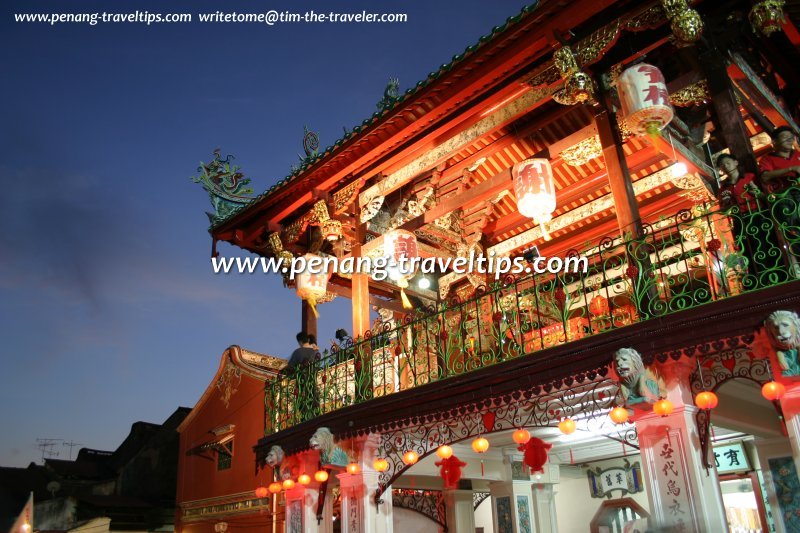 Cheah Kongsi Ancestral Temple (13 February 2005)
Cheah Kongsi Ancestral Temple (13 February 2005)
I remember a few years ago I was in the presence of a local historian, and someone asked her, "What's a Straits-born Chinese?" She answered that it is simply a person who was born in Malaya. If that is the case, wouldn't all local-born Chinese people be called Baba Nyonya? She was not able to provide a satisfactory response, because she was not able to pin-point the difference between the two. This however fueled my interest to find the right answer.
What I am sharing with you here is based on research and hypothesis. I include hypothesis because some times, I have no choice but to fill in the gaps based on deduction. It's like explaining a jigsaw puzzle where some pieces remain missing. However I do believe most of the pieces are in place, so I can provide you a clear explanation now. But with all things to do with history, new future evidence may modify what I write today.
History of the Penang Chinese People
Why did the Chinese people leave China? Let me put it this way: "If you bang the table, crumbs fall off."Every time there is turbulence and calamity in China, there would be a wave of refugees seeking better life elsewhere. The Straits Chinese and the Sin Kheh are the product of two separate waves of exodus from China.
Present-day locations of Zhangzhou and Xiamen
Who are the Straits Chinese
The Straits Chinese of Penang trace their ancestry to seafarers who left the coastal areas of Fujian Province in China. They originate from and around the city of Zhangzhou. They populated the coastal areas of the Malay peninsula, from Penang northwards to Phuket, as well as Medan.The Straits Chinese of Penang speak a different dialect of Hokkien from a different group, which came from and around the city of Xiamen (Amoy), and who populated the southern part of the Malay peninsula, from Malacca down to Singapore. The Penang Hokkien was developed from the Middle Chinese phonology which was introduced to the Zhangzhou area by the Tang Dynasty general Chen Zheng (陳政/陈政) in the 7th century AD.
When did the ancestors of the Straits Chinese of Penang leave China for the Malay peninsula? Chinese seafarers had been leaving the coastal provinces of Fujian and Guangdong since the 15th century. The Chinese who settled in Malacca probably arrived earlier, during the time of the Malacca Sultanate. (The so-called Princess Hang Li-Po, if she existed at all, was quite likely someone drawn from this community and - unless there is conclusive proof - her links with the Ming Dynasty emperor may well be fanciful embellishment of history.) This explains their assimilation and how much their dialect has been modified by the local Malay language. The Peranakan of Malacca have adopted Malay as their mother tongue, with borrowed words from Hokkien, while the Baba Nyonya of Penang speak Hokkien with borrowed words from Malay.
It takes time for a people to embrace the language of the adopted land. For that reason, the ancestors of the Malacca Straits Chinese must have arrived longer than the Penang Straits Chinese.
So when did the ancestors of the Penang Straits Chinese arrive? I believe it would be some time between the 17th and early 18th century. They did not come straight to Penang, but populated the coastal settlements of the Kingdom of Kedah, settling in places such as Prai, Kuala Muda and Kuala Kedah. Why did they choose to leave China? The Ming Dynasty collapsed and was replaced by the Qing Dynasty in 1644. This brought huge turbulence to the country that rippled all the way to the southern provinces. Also, they were not willing to be ruled by the Manchu people, whom they did not regard as Han Chinese. So they voted with their feet.
There was sporadic rebellion along the coastal parts of China against Manchu rule throughout the 17th century. It culminated with the imperial edict issued by Emperor Kangxi (1654-1722) that the coastal region be evacuated. The purpose was to flush out Ming sympathizers. Although the majority of the population moved inland, some of the Hokkien-speaking people choose to leave China to resettle in Taiwan and other parts of the Nanyang, including Malaya. They, I believe, are the ancestors of the Penang Straits Chinese. They arrive in northern Malaya before Francis Light founded George Town. It's hard to say whether any of the original settlers came to stay in Penang Island itself, but by the time Francis Light came into the picture, there were already settlements of Chinese people in Prai and Tanjong Tokong.
Back in China, when the threat of rebellion in the southern provinces have been quashed, the Qing Government issued another edict for the coastal region to be re-populated. This time, in addition to the Hokkien-speaking people, the coastal region also saw the arrival of the Hakkas. The Hokkiens, who have been living in Fujian longer, did not particularly embrace the arrival of the Hakkas. To protect their position, the Hakkas built tulou, communal houses that face inward. The Hokkiens called the Hakkas the Khek1 Lang2, meaning "guest people", while they called themselves Pun1tay3 Lang2, meaning "local people".
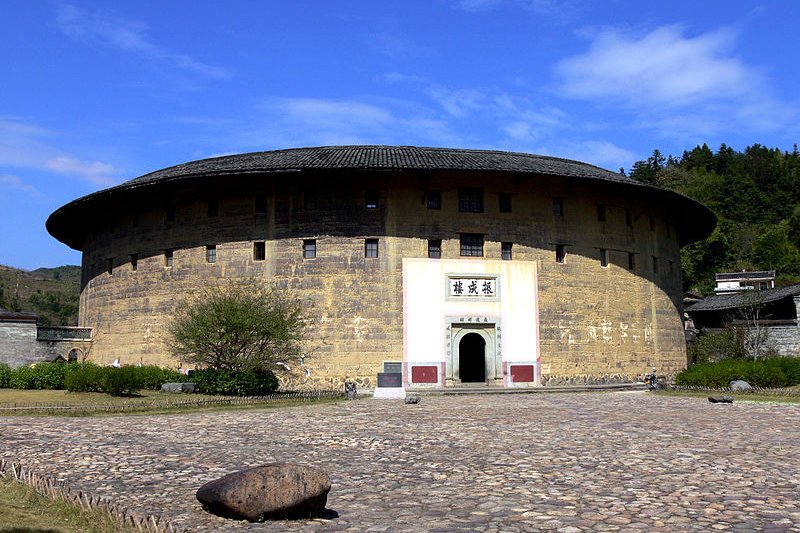 Fujian tulou, home of the Hakka settlers in Fujian province
Fujian tulou, home of the Hakka settlers in Fujian provinceAuthor: Gisling (Creative Commons Attribution 3.0 Unported)
The Hokkien people have settled in Malaya for generations by the time Francis Light arrived in Penang. During that period, they have borrowed local words into their dialect which is very pliable considering most of them were illiterate. Over the generations their ties with their Chinese homeland were weakened, and for many, completely severed. They are more willing to accept Malaya as their motherland, and under the British colonial government, they would send their children to English schools, the product of which being English-speaking Chinese people, yellow on the outside, but thoroughly white within. Some became very wealthy in business, and their choice of name for their homes reflect their Anglophile slant.
Who are the Sin Kheh?
You will notice that most of the towns in Malaysia where Hokkien is predominantly spoken are located along the coast. This suggest that they were settled a very long time ago by people who made a living from the sea. There was no reason for the Hokkiens to move inland. By comparison, the towns further inland use Cantonese as the spoken language. It was because of tin mining that these towns were established, and it only happened from the mid 19th century onwards.The Straits Chinese have been in Penang for several generations before the Sin Kheh arrived. In the mid 19th century, southern China was again rocked by upheavals, this time brought on by the Taiping Rebellion (1850-1864). Although later Chinese leaders such as Sun Yat-sen and Mao Zedong glorified the Taiping rebels as early heroic revolutionaries, the conflict killed some 20 million people and created a new wave of refugees.
Meanwhile, in a valley in Perak in 1848, Malay chieftain Long Jaafar through his pet elephant Larut discovered tin ore in the area that would eventually bear its name. This coincided with the Industrial Revolution in Great Britain, which caused the demand for tin to rise. The call for coolies to extract the tin was answered by waves of Chinese immigrants.
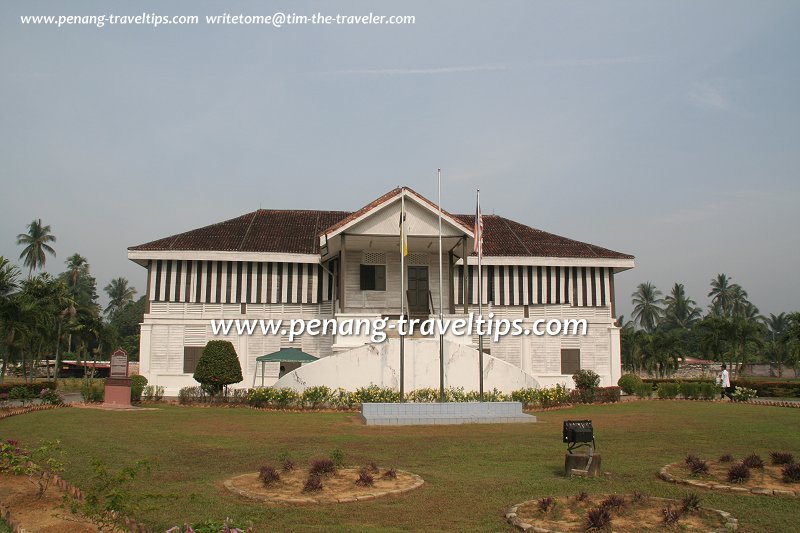 Kota Ngah Ibrahim, residence of the Malay nobleman whose father ignited the tin rush. The building bear witness to all the upheavals caused by tin mining. (17 May 2008)
Kota Ngah Ibrahim, residence of the Malay nobleman whose father ignited the tin rush. The building bear witness to all the upheavals caused by tin mining. (17 May 2008)
To the Straits Chinese, these newcomers were the Sin Kheh, meaning "new guests". Of course, although the term kheh or "guest" was used, the newcomers were never accepted with full embrace. They have, after all, arrived to share the pie, so they were grudgingly accommodated as the Stratis Chinese needed labourers to handle the labour-intensive jobs. Many of these so-called guests became the inhabitants of piers that became known as the Clan Jetties.
I can't help noticing how much more polite the term "guest" was used, even if they don't fully mean it. In a way, it's similar to the Germans calling Turkish workers "Gastarbeiter", meaning "guest workers". Today Indonesian maid are often called "Innee Poh" while Bangladeshi referred as "Bangla", terms which sound so derogatory.
Nonetheless the Sin Kheh are a different beast from the Straits Chinese. Many of them arrived in Penang penniless, often with only the clothes on their backs. But Penang of the late 19th century was a boom town fueled by tin. Close to one hundred years after it was established, the city finally enters its golden age. This brought an influx of immigrants, not only Hokkien but due to the Taiping Rebellion, Cantonese, Hakka and other southern Chinese minorities also.
A new Chinese immigrant arriving in Penang would belong to a clan that would offer you help to get started. In any case, where he came from would determine where he would head upon arrival. The Hokkiens form clan associations, based on their clan villages back home, while the Cantonese form district associations, loosely the same thing.
Unlike the Straits Chinese, their ties to the homeland is still pretty strong. Incredibly diligent and tenacious, many found wealth. People such as Cheong Fatt Tze and Chung Keng Quee were Hakka, hence Sin Kheh, who made it big in this region.
Until the early part of the 20th century, when followers of Sun Yat-sen pushed for the use of Mandarin, Hokkien was the lingua franca of the Chinese people in Penang. This was the language established by the Straits Chinese by virtue of their arrival here ahead of anybody else. Even the major Chinese schools in Penang initially taught in Hokkien before switching later on to Mandarin.
During the early 20th century, right up to Independence, the Straits Chinese are more likely to send their children to English schools while the Sin Kheh, with their intention to return to their homeland in China, sent their to Chinese schools. Having said that, the Straits Chinese did make an attempt to learn Chinese, such as in the founding of the Hu Yew Seah.
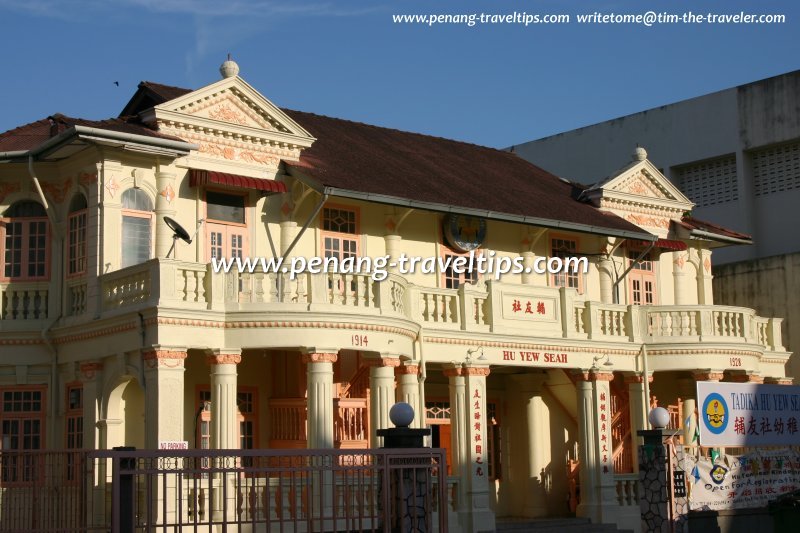 The Hu Yew Seah, early attempt by the Straits Chinese to trace their roots (1 August 2006)
The Hu Yew Seah, early attempt by the Straits Chinese to trace their roots (1 August 2006)
The condition shifted after Independence, when the change in Education policy saw both groups accepting Malaya as their new homeland. However, they now send their children to Chinese schools. The boost in the use of Mandarin was at the expense of Hokkien and other vernacular dialects which are all regarded as the language of those who are quaint and unsophisticated.
Today, as Penang prides itself as home to a World Heritage Site, and there is much interest in our heritage, it is sad that the position of Hokkien continues to slide, taking with it the local Hokkien culture.
If you're a Penang-born Chinese, you are one or the other. If you know that your parents, grandparents or great grandparents came from China, you are most likely a Sin Kheh, as your arrival in Penang happened following the Taiping Rebellian took place. On the other hand, if you can no longer trace the origin of your forefathers, your parents and grandparents were English educated, you speak Hokkien with a liberal adoption of Malay words, you are possibly a Straits Chinese.
In my case, my father is Sin Leng, which puts me within the Sin Kheh group. On the other hand, my mother is Hokkien, and her ancestry shows that she came from the Baba Nyonya group. Due to my paternal side, as much as I want, I couldn't count myself to be a true blue Baba Nyonya although I am as Straits Chinese as it gets. I am English educated, as were my parents. I believe my paternal forefathers would have arrived in Malaya in the second half of the 19th century.
It doesn't really matter whether you are Baba Nyonya or Sin Kheh. The more important point is that we appreciate our roots, and even as we stand to regain an awareness of our tangible heritage, it's time we resuscitate our local culture, which includes not only the Penang food and the Penang nursery rhymes, but also the Penang Hokkien language.
Comments
Daniel Boey: Firstly, the over-whelming majority of the Penang Chinese are sin-keh's. In Indonesia, the sin-keh's are called "totok's" & whereas their equivalent of the babas, the "peranakan". My paternal grandpa came at the turn of the century whereas my maternal great-grand-father came around 1870.Around that time, the Zhangzhou hokkiens had been around and there used to be a lot of trade in the triangle of Penang-Phuket-Medan. In fact, the so-called founder of Penang, Capt Francis Light, used to stay in Phuket where he met his Eurasian girl-friend/bride (?) before he came to Penang. The Zhangzhou hokkiens also congregate in Kelantan as well as around Kuching, Sarawak. That's why, even though the accents are slightly different in these 3 regions, they still maintain a characteristic way of pronouncing certain words. For e.g. we say, "mui/knui/tnui" (door/bright/return) instead of "mng/kng/tng" (as spoken by those speaking the standard Xiamen/Am'ng/Amoy dialect). Another example is "hoei/keh" (fire/chicken) instead of "heh/koe". Some pronounce "her" for fire. Those from Singapore & Malacca speak a variety closer to that from Xiamen.
Even though Penang's lingua franca was/is Hokkien, there are also a very sizeable group of Cantonese & Hakka's (hakka's predominate in Balik Pulau; there, they're Catholic too). In fact, there are many lanes around Weld Quay that were Cantonese-infested. Actually, a huge number of the so-called Cantonese were actually from the Sining variety. These are sometimes called Toishanese/Taishanese/Sei Yap, etc. They came from Sining, a few hour's drive from Macao or Shenzhen. Sining was the old name for Taishan or Toishan & the name was changed (from Sining) after the Kuomintang took over China. Toishan was one of the 4 distrcits (Sei Yap) that consisted of Yan Ping, Hoi Ping, San wui & San Ning ("Sining" in hokkien). Toishan was the principle sender of rail-road workers to America to build the railway from the pacific to the mid-west (where they are met by the Irish railroad workers) at the end of the 19th century.
Now, the early Straits-born Chinese wore a similar costume. All the way from Phuket to Singapore (the Singapore Baba's actually migrated from Malacca) they were in that attire. However, since the Malaccan baba's had been there earlier, there was a great deal of inter-marriage between the early Malaccan settlers and the local women (that was ok those days!), the descendents of which retained the Chinese religious practices but spoke a Malay patois. Those in the north spoke a bastardized Zhangzhou dialect that had a vocabulary that was borrowed heavily from the Malays & other groups (for e.g. there are many Teochews all the way from Bukit Mertajam to Nibong Tebal). That's why "handkerchief" is "panjiu" - which is more Teochew than Hokkien. However, the Penang Teochew is in turn diluted to an extand that an old Teochew from Bangkok or J.B. would think that it's like Hokkien. And so.....the Penang Chinese are from this melting pot of Zhangzhou Hokkiens AND Teochews & Canto-sining's & Hakka's & Malays.
Related articles in Wikipedia
Learn Penang Hokkien with Memrise
Now you can use the most user-friendly tool on the web to learn Penang Hokkien. It helps you to listen, understand and memorise. Go to Memrise, and learn Penang Hokkien at your own pace. [an error occurred while processing this directive]
[an error occurred while processing this directive]
Copyright © 2003-2025 Timothy Tye. All Rights Reserved.

 Go Back
Go Back